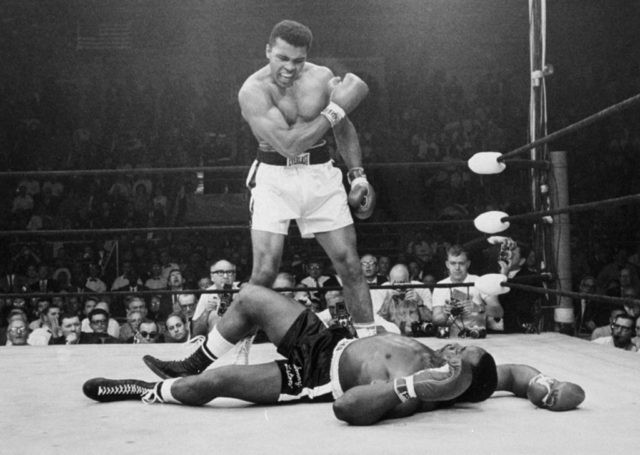Muhammed Ali overcame 8-1 odds to defeat Sonny Liston in 1964. But the long-suffering boxer couldn’t overcome the odds stacked against him in a Phoenix hospital room Friday night.
The most transcendent figure in sports history passed away after a long bout with Parkinson’s and a brief battle with respiratory issues.
Muhammad Ali was larger than life if smaller than Tyson Fury, Wladimir Klitschko, or any top heavyweight competing today. Hollywood cast Terrence Howard, Will Smith, and, most convincingly of all, Muhammad Ali, to portray Muhammad Ali in the movies. A year after releasing an LP on Columbia Records, he knocked down all four Beatles in a ring in Miami. A decade later, he entered the squared circle against Ken Norton wearing a robe given to him by Elvis Presley. He fought a hockey goon, an All-Pro defensive end, and several professional wrestlers in exhibition matches. He even squared off against Superman in a comic book. Ali, or his voice at least, starred in his own Saturday morning cartoon, and that ubiquitous and unmistakable voice hawked Muhammad Ali’s Crisp Crunch, The Champ’s Premium Shoe Polish, and much else.
He first entered a professional boxing ring when Dwight Eisenhower served as president. He last exited the ropes when Ronald Reagan reigned in the White House. In between, the boxer converted to the Nation of Islam, curiously declared himself a conscientious objector during the Vietnam War (“My enemy is the white people, not Vietcongs or Chinese or Japanese”), and won a decision unanimously at the Supreme Court (judges really liked him—just ask Ken Norton) on a technicality. We loved him anyway.
We loved him most because he made the ugliness of violence incredibly beautiful. He displayed the footwork and hand speed of a welterweight. But he hit like a heavyweight. The “Ali Shuffle” put opponents, like Sonny Liston, in awkward positions. The “Float Like Butterfly, Sting Like a Bee” approach, used memorably en route to a third-round stoppage of Cleveland Williams, combined movement and an accumulation of stings to fell opponents. The “Rope-a-Dope” strategy wore down George Foreman, with the aid of some ridiculously loose ring ropes and a protective possum stance, to the point where the accumulation of punches resulted in the big Texan stumbling around in the African heat as though drunk off Kinshasa Lotoko. He measured a mere 78 on an Army IQ test (“I said I was the greatest, not the smartest”). But in a boxing ring “The Greatest” was the smartest.
He certainly had a smart mouth, which offended people on every continent. “Thank God my granddaddy got on that boat,” he said when asked to give his thoughts on Africa after his eighth-round knockout of George Foreman in Zaire. “Muhammad Ali has returned!” he boasted upon arriving in Japan to fight professional wrestler Antonio Inoki in an exhibition match. “There will be no Pearl Harbor! There will be no Pearl Harbor!”
That voice slowing, weighed down by huskiness by the late 1970s, did not stop him from ill-advised matches with Leon Spinks, Larry Holmes, and Trevor Berbick. But the real damage to the man never knocked out in his 61 professional fights came earlier. The monstrous fifteenth-round left from Joe Frazier in 1971 and their brutal, life threatening Thrilla in Manila four years later; his trilogy with Ken Norton, in which the Black Hercules broke his jaw in the first fight and pounded him in the last one; and in any number of blows he took from concrete-fisted Earnie Shavers, a pyrrhic victory that jolted Dr. Ferdie Pacheco to abandon Ali’s side and urge him to abandon boxing, all contributed to seal his sad but predictable fate. The no-quit spirit that allowed him to outlast Joe Frazier in the Philippines served him poorly in the last rounds of his career.
“There are a lot of people who have Parkinson’s that never boxed,” he mumbled to Phil Donahue a decade after his career ended, adding: “I don’t think it was boxing.” But Jerry Quarry, Jimmy Ellis, Floyd Patterson, and other past opponents developing debilitating neurological conditions made everyone else think it was.
His remarkable life inside and outside the ring makes it difficult for any boxer to eclipse him. His sad decline away from prize fighting makes it all the more difficult for any practitioner of the sweet science to captivate the public the way he did. Muhammad Ali, whether at his peak standing above Sonny Liston or at his low point shaking and muttering, ensured that we could never watch boxing the same way again.

COMMENTS
Please let us know if you're having issues with commenting.